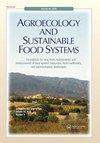油菜加工废料制备蛋白质的技术现状及发展前景
IF 2.6
3区 农林科学
Q1 AGRICULTURE, MULTIDISCIPLINARY
Agroecology and Sustainable Food Systems
Pub Date : 2023-07-12
DOI:10.21323/2618-9771-2023-6-2-159-170
引用次数: 2
摘要
由于世界人口的增长,对蛋白质产品的需求正在增加。作为传统蛋白质来源的替代品,植物原料加工产生的废物正变得越来越受欢迎。油籽,特别是油菜籽在全球经济中占有重要地位,俄罗斯联邦的油菜籽产量每年都在增加。油菜籽(Brassicaceae napus)因其含油量高(39.80-46.00%)和脂肪酸组成丰富而备受关注,而油菜籽在产油过程中形成的饼和粕的粗蛋白质(35.00-45.00%)和粗纤维(8.20-17.50%)含量显著;然而,它们主要用作饲料添加剂。最近关于油菜籽废料加工的研究表明,这种原料具有作为膳食蛋白质来源的价值,它具有均衡的氨基酸结构和高消化率(高达85%)。为了获得蛋白质,设想油菜籽加工:清洗,研磨,在≤40°C的温度下冷压,用溶剂提取脂肪。下一阶段,用0.1-0.5 M NaCl, pH 5.3-12.0,温度5-30℃,提取1小时。提取的蛋白质在等电点(pH 4.0)用盐酸沉淀,从混合物中分离并中和。分离得到的蛋白含量为90.0 ~ 98.7%。由于用纤维素酶制剂加工脱脂饼的额外阶段,有可能提高蛋白质产品的质量和产量。在这种情况下,需要进一步的研究来确定商业纤维素酶制剂的底物特异性和最佳水解条件。在使用酶解阶段的情况下,还应指定蛋白质的提取和沉淀参数。本文章由计算机程序翻译,如有差异,请以英文原文为准。
Protein preparations from rapse processing waste: A review of the current status and development prospects of existing technologies
The demand for protein products is increasing due to the demographic growth of the world’s population. As an alternative to traditional sources of protein, waste from plant raw material processing is becoming increasingly popular. An important place in the global economy is occupied by oilseeds, in particular rapeseed, which production volumes are increasing in the Russian Federation every year. Rapeseed (Brassicaceae napus) is of great interest due to its high oil content (39.80–46.00%) and rich fatty acid composition, while cake and meal formed in the process of oil production are characterized by a significant content of crude protein (35.00–45.00%) and crude fiber (8.20–17.50%); however, they are used mainly as a feed additive. Recent studies on the processing of rapeseed waste indicate the value of this raw material as a source of dietary protein, which has a balanced amino acid profile and a high degree of digestibility (up to 85%). To obtain protein, rapeseed processing is envisaged: cleaning, grinding, cold pressing at a temperature of ≤ 40 °C, fat extraction with a solvent. At the next stages, the protein is extracted with 0.1–0.5 M NaCl at pH 5.3–12.0 and a temperature of 5–30 °C for 1 hour. The extracted protein is precipitated at the isoelectric point (pH 4.0) with HCl, separated from the mixture and neutralized. The result is a protein isolate with a protein content of 90.0–98.7%. It is possible to increase the quality and yield of the protein product due to the additional stage of processing the defatted cake with cellulolytic enzyme preparations. In this case, additional studies are required to determine the substrate specificity of commercial cellulase enzyme preparations and the optimal hydrolysis conditions. The parameters of extraction and precipitation of the protein in the case of using the stage of enzymatic lysis should also be specified.
求助全文
通过发布文献求助,成功后即可免费获取论文全文。
去求助
来源期刊

Agroecology and Sustainable Food Systems
AGRICULTURE, MULTIDISCIPLINARY-GREEN & SUSTAINABLE SCIENCE & TECHNOLOGY
CiteScore
4.80
自引率
7.70%
发文量
73
期刊介绍:
Agroecology and Sustainable Food Systems is devoted to the rapidly emerging fields of agroecology and food system sustainability. By linking scientific inquiry and productive practice with transformative social action, agroecology provides a foundation for developing the alternative food systems of the future. The journal focuses on the changes that need to occur in the design and management of our food systems in order to balance natural resource use and environmental protection with the needs of production, economic viability, food security, and the social well-being of all people.
Agroecology and Sustainable Food Systems examines our current food systems from production to consumption, and the urgent need to transition to long-term sustainability. The journal promotes the study and application of agroecology for developing alternatives to the complex problems of resource depletion, environmental degradation, a narrowing of agrobiodiversity, continued world hunger, consolidation and industrialization of the food system, climate change, and the loss of farm land. The journal uses a food systems approach, and seeks experiences in agroecology that are on-farm, participatory, change-oriented, and backed by broad-based methodologies of sustainability analysis and evaluation.
 求助内容:
求助内容: 应助结果提醒方式:
应助结果提醒方式:


